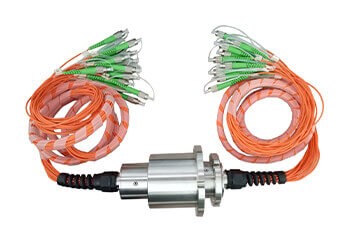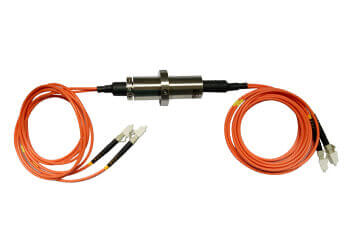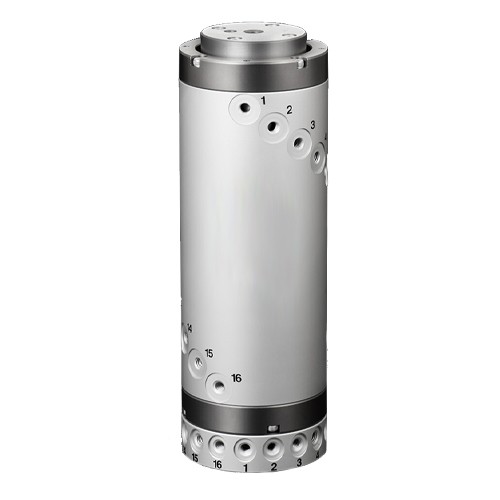Forget just brute force. The next generation of excavators is defined by precision, efficiency, and sustainability. At the heart of this transformation, especially in the critical shift from diesel-hydraulic to electric-hydraulic systems, lies a component often overlooked but absolutely vital: the Hydraulic Rotary Joint (HRJ). Let’s explore how these sophisticated “swivels” are enabling the future, using Servoday’s innovative electric excavator conversion as a compelling case study.
The Challenge: Electrifying the Hydraulic Beast
Traditional excavators rely on a diesel engine driving hydraulic pumps, sending pressurized fluid through hoses to cylinders and motors. Key to the excavator’s function is the upper structure (cab, engine, counterweight) rotating continuously over 360 degrees relative to the under carriage (tracks, frame). This is where HRJs come in. They are the critical interface, allowing hydraulic fluid (and often electrical signals, coolant, or air) to flow continuously between these rotating parts without leaking or tangling hoses.
Electrification introduces new demands:
Higher Efficiency: Every drop of hydraulic fluid and every watt of electricity counts. Leaks or pressure drops in the HRJ directly impact battery life and performance.
Precision Control: Electric excavators excel at fine control for tasks like grading or delicate demolition. The HRJ must transmit pressure signals flawlessly for responsive valve control.
Compactness & Weight: Electric components (batteries, motors) add weight/size. The HRJ needs to be compact and lightweight to avoid compromising balance or space.
Heat Management: Electric motors and high-efficiency hydraulics can generate significant heat, which the HRJ must withstand or help manage.
Reliability & Longevity: Downtime is costly. Electric excavators promise lower maintenance – the HRJ must be exceptionally durable.
The Hydraulic Rotary Joint: The Unsung Enabler
This is where the Hydraulic Fiber Optic Rotary Joints becomes indispensable. It acts as a sophisticated, rotating manifold, forming the critical hydraulic connection between the upper and lower structures across the excavator’s slew ring. Its primary functions are:
Continuous Fluid Transfer: Seamlessly delivers hydraulic fluid under high pressure (often 250-350+ bar) from the stationary side to the rotating side, and returns used fluid back.
Unlimited Rotation: Allows the excavator’s upper structure to rotate freely and continuously in either direction without tangling or stressing hydraulic hoses.
Multiple Flow Paths: Houses multiple independent fluid channels (ports) within a compact unit. A typical excavator HRJ might handle 4-8 separate lines for functions like boom lift/lower, arm in/out, bucket open/close, auxiliary circuits, and pilot control signals.
High-Pressure Sealing: Maintains critical seals between the rotating and stationary parts under extreme pressure, preventing leaks and ensuring efficiency.
Robustness & Reliability: Designed to withstand harsh construction environments – dirt, dust, vibration, shock loads, and temperature extremes.

Servoday’s Electric Conversion: Where the HRJ Shines
Servoday, leveraging its deep hydraulic expertise, is actively converting conventional excavators to electric power. Their approach highlights the HRJ’s pivotal role:
Multi-Passage Mastery: Servoday utilizes advanced HRJs capable of handling multiple independent hydraulic circuits simultaneously:
High-Pressure Supply: Delivering power from the electric pump (driven by the battery-powered motor) on the upper structure to the main control valves.
Low-Pressure Return: Efficiently channeling return fluid back to the reservoir/tank.
Pilot Pressure Lines: Transmitting the low-pressure signals crucial for precise electronic valve control.
(Optional) Auxiliary Circuits: For attachments like breakers or grapples.
(Optional) Coolant/Electrical: Integrated passages for motor/inverter cooling lines or data/power cables (hybrid HRJ/Electrical Slip Ring units).
Sealing the Deal on Leakage: Servoday employs state-of-the-art sealing technologies within their HRJs:
Advanced Materials: Highly wear-resistant polymers and composites compatible with modern biodegradable hydraulic fluids.
Precision Engineering: Ultra-tight tolerances in sealing surfaces minimize internal leakage, preserving pressure and maximizing efficiency – directly extending battery runtime.
Robust Designs: IP-rated sealing protects internal components from harsh environments (dust, mud, water ingress).
Optimized for Electrification:
Low Torque Requirement: Servoday designs focus on minimizing rotational friction. Less force is needed to turn the joint, reducing parasitic losses and improving overall system efficiency – a critical factor for battery life.
High Flow Efficiency: Optimized internal porting minimizes pressure drops across the joint, ensuring hydraulic power reaches the actuators effectively.
Thermal Management: Materials and designs are chosen to withstand the potentially higher ambient temperatures near electric motors and inverters.
Compact & Lightweight: Designed to fit within the spatial constraints of retrofitted electric systems without adding excessive weight.
Integration & Intelligence:
Sensor Integration: Advanced HRJs can incorporate sensors (temperature, pressure, rotation speed) providing valuable data for predictive maintenance and system optimization.
CAN Bus Compatibility: Facilitating communication between the joint’s health monitoring and the excavator’s central control system.

The Payoff: Why Servoday’s HRJs Enable Next-Gen Performance
By leveraging high-performance hydraulic rotary joints specifically adapted for electrification, Servoday’s conversions achieve significant benefits:
Extended Battery Life: Minimized leakage and pressure drops translate directly into longer operating shifts between charges.
Enhanced Precision & Responsiveness: Consistent, reliable transmission of pilot pressures ensures the electric controls operate the hydraulics with exceptional accuracy.
Increased Uptime & Reliability: Durable, low-leakage HRJs significantly reduce maintenance needs and unexpected failures.
Quieter Operation: Well-sealed HRJs contribute to the overall reduction in noise pollution – a major advantage of electric excavators.
Reduced Environmental Impact: Less hydraulic fluid leakage and lower energy consumption contribute to a cleaner worksite and lower carbon footprint.
Smoother Operation: Low-friction joints contribute to smoother slewing motion.
Beyond Efficiency: Operational Advantages in the Field
Servoday’s HRJ-enhanced electric excavators deliver tangible benefits on the job site:
Urban Jobsite Viability: Significantly reduced noise makes these machines ideal for sensitive environments like hospitals, schools, or night work in cities, where diesel machines face restrictions.
Operator Comfort & Focus: Lower vibration and noise levels reduce operator fatigue, leading to better concentration, fewer errors, and improved safety over long shifts.
Reduced Heat Signature: Unlike diesel engines, electric systems generate less radiant heat, an advantage in hot climates or confined spaces.
Instant Torque Advantage: The combination of electric motors and optimized hydraulics provides superior responsiveness for demanding tasks like trenching or lifting.

The Maintenance Revolution: Lower TCO with Advanced HRJs
Electrification combined with robust HRJ design drastically changes the maintenance paradigm:
Eliminated Diesel-Related Maintenance: No oil changes, fuel filters, DEF systems, or exhaust after-treatment servicing.
HRJ Longevity: Advanced seals and materials significantly extend service intervals compared to standard joints. Servoday’s focus on durability means fewer replacements over the machine’s lifetime.
Predictive Maintenance Enabled: Integrated sensors in the HRJ provide early warnings for potential issues (like seal wear or contamination ingress), allowing proactive servicing and preventing costly unplanned downtime.
Simplified Fluid Management: Reduced leakage means less top-up fluid is needed, lowering operational costs and environmental spill risk. Compatibility with eco-fluids is easier to maintain.
Reduced Downtime: Fewer components to fail (no diesel engine) combined with reliable HRJs means machines spend more time working and less time in the shop.
Quantifying the Impact: Servoday’s HRJ Contribution to Electrification ROI
While the electric motor and battery are major cost drivers, the HRJ plays a crucial role in maximizing return on investment:
Energy Savings Attribution: Servoday estimates their optimized HRJs contribute a 5-10% improvement in overall hydraulic system efficiency compared to standard joints. This directly translates to extended battery life per charge, reducing the required battery size/cost or increasing daily productivity.
Downtime Cost Avoidance: The enhanced reliability of their HRJs minimizes unexpected breakdowns related to the critical rotation point. Reduced maintenance frequency also lowers labor costs and parts inventory.
Fluid Cost & Disposal Savings: Dramatically reduced leakage lowers the annual cost of hydraulic fluid and associated disposal fees for used fluid and contaminated soil cleanup.
Longevity & Resale Value: A robust HRJ designed for the long haul protects the investment in the electric conversion kit and supports higher residual machine value.
The Future of Rotary Power Transfer: Servoday’s Vision
Servoday isn’t just adapting; they’re innovating for the next phase:
Integrated Smart HRJ Modules: Combining hydraulic passages, high-power electrical slip rings, high-speed data transmission (Ethernet), and coolant lines into a single, sealed, modular unit for plug-and-play installation in new OEM designs.
Advanced Health Monitoring: Expanding sensor suites within the HRJ (vibration, particle count) feeding AI-driven predictive maintenance platforms for ultimate fleet uptime.
Material Science Frontiers: Exploring novel composites and surface treatments for near-zero friction and wear, pushing efficiency and lifespan boundaries.
Standardization for Electrification: Developing HRJ specifications and interfaces optimized for electric excavator platforms, facilitating faster adoption and conversion by OEMs and retrofit specialists.
Hydraulic rotating union are far more than simple plumbing connectors. They are precision-engineered, mission-critical components that dictate the efficiency, reliability, and performance of hydraulic systems, especially in the demanding context of electric excavators. Servoday’s case study demonstrates that successful electrification isn’t just about swapping an engine for a motor and batteries; it requires a holistic re-engineering of core systems, with the HRJ being a linchpin. By prioritizing advanced HRJ technology designed for the unique challenges of electrification – efficiency, compactness, reliability, intelligence, and integration – Servoday ensures that vital hydraulic power seamlessly flows through the excavator’s rotating heart. This unlocks the true potential of silent, powerful, precise, and sustainable next-generation excavation. The revolution isn’t just electric; it’s enabled by the intelligent, high-performance swivel at its core.
See What We Can Do

